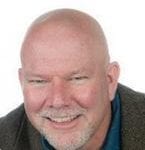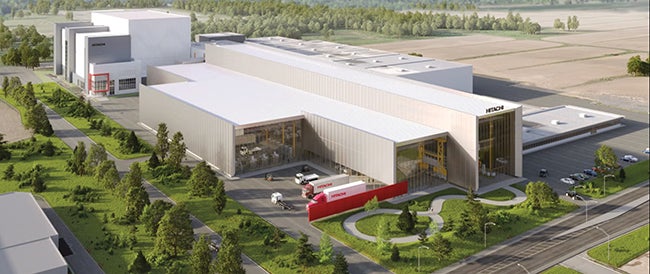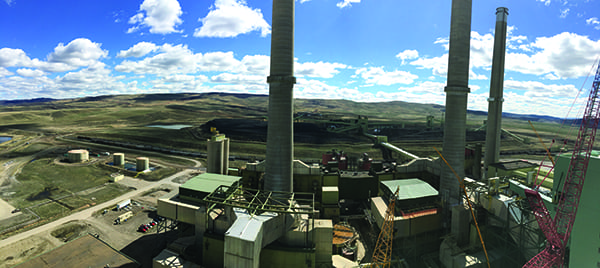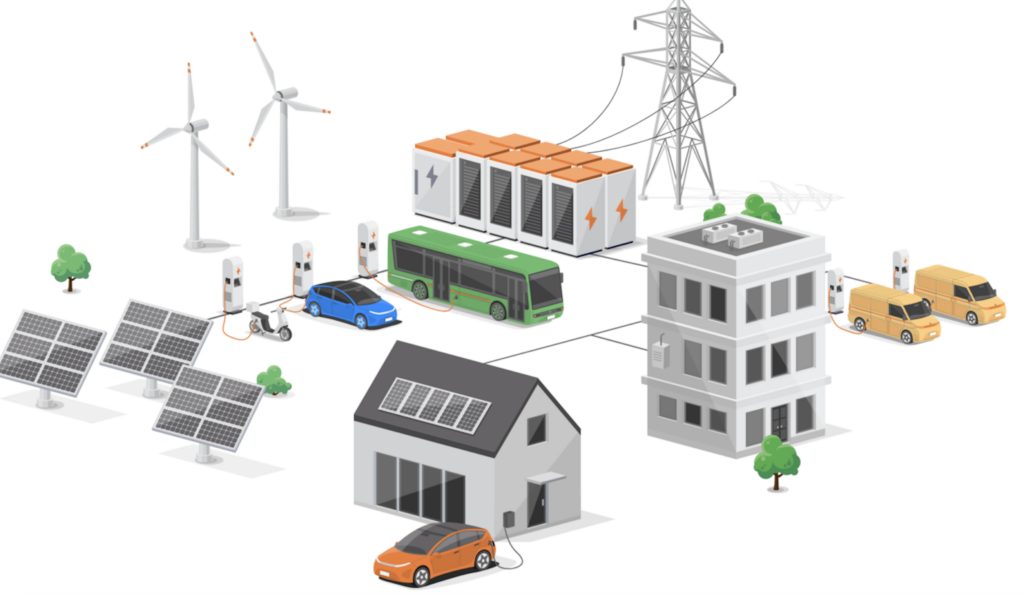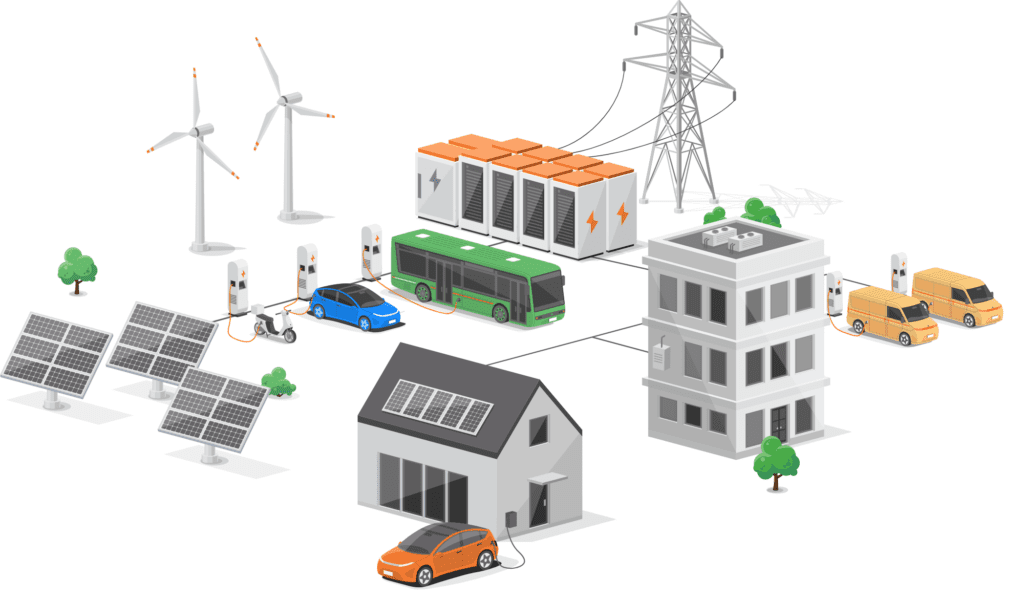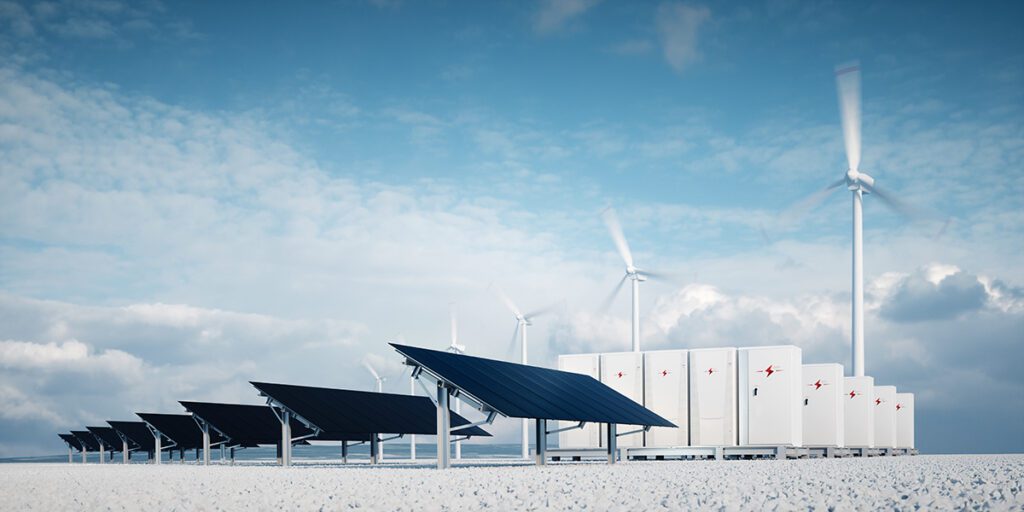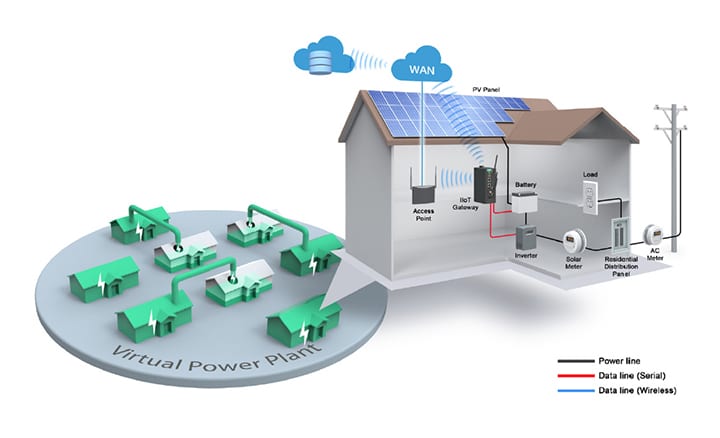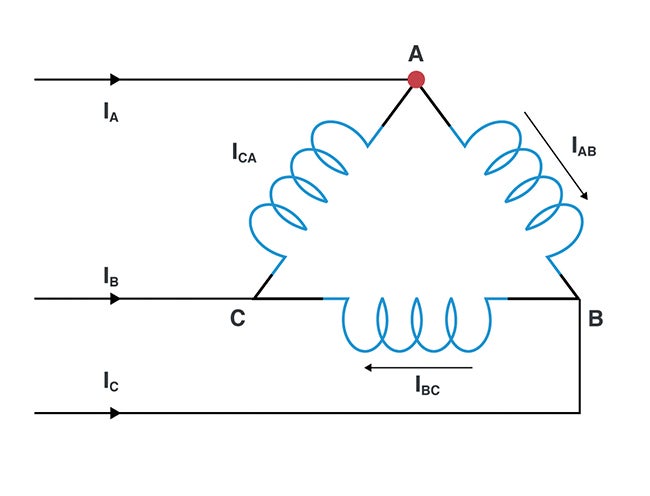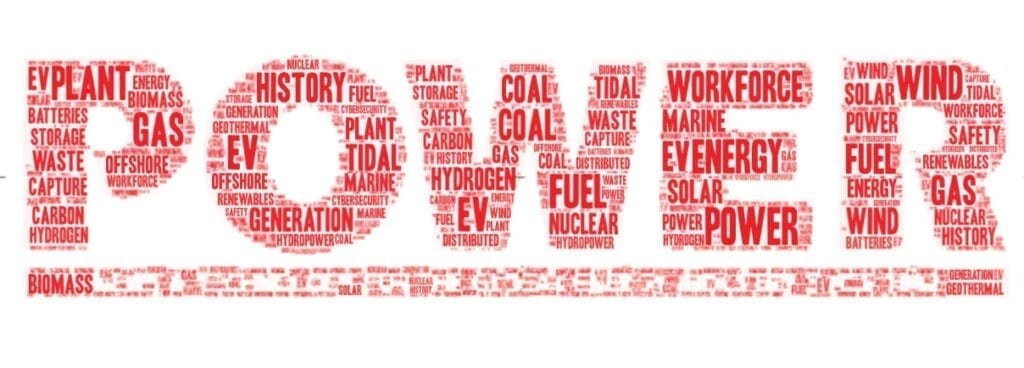The use of distributed energy resources (DERs) will continue to grow as utilities, businesses, and residential neighborhoods look for ways to balance the power grid and support more reliable and resilient electricity.
The use of distributed energy resources (DERs) continues to grow as individuals and businesses look for more control of their energy costs and electricity supply. The use of on-site generation technologies, including solar panels, batteries, small wind turbines, and gas- and diesel-powered generators, is helping power customers mitigate the impacts of grid outages and high prices for electricity.
DERs help local utilities by contributing to a more resilient and sustainable power supply. Customers may have the opportunity to sell excess electricity back to the grid during periods of peak demand; in addition, DERs are the backbone of virtual power plants (VPPs) that are enabling utilities to better manage the power supply, and avoid the cost of building new physical power generation facilities.
The use of decentralized power production means utilities and their customers no longer have to rely on a single generation resource, but rather can utilize a variety of technologies to mitigate the impact of extreme weather and other issues. The use of DERs in microgrid configurations allows for a steady supply of energy in remote locations, an important consideration for military bases and other businesses with a need to operate in areas far from the traditional power grid.
“DER programs allow utilities to shave peak demand, balance supply and demand, and reduce energy losses during transmission and distribution, thus offering a far more stable and efficient grid for everyone. Utilities should not only be involved but further incentivize more adoptions, creating a more resilient, flexible, and economically efficient energy system,” said Shawn McLaughlin, CEO and founder of Emporia, a Colorado-based energy management solutions provider. “At the state level, utility incentive programs have led to growth in DER programs like solar rebate programs and efficiency loans, reduced costs for efficient or renewable technologies, and water conservation incentives. These programs further support technology and encourage more residential and commercial adoptions of smart energy technologies.”
Jeff Simmons, senior vice president at Toshiba America Energy Systems, said, “DERs are more than just a backup power. They’re shaping a more future-ready and resilient ecosystem that allows businesses and communities to better manage resources, reach their sustainability goals, and achieve long-term energy independence. There’s no doubt that distributed energy resources are revolutionizing the energy landscape by helping businesses and homes improve energy reliability, resilience, and sustainability. At Toshiba, we are working on advanced DER solutions and anticipate great potential in their growth.”
Clean Energy Economy
The energy experts who spoke with POWER noted that the use of DERs also represents a key part of a clean energy economy. Their deployment allows for more electricity from solar (Figure 1), wind, and battery storage, along with biogas, hydrogen, and other lower-emission fuels. They also bring a reduction in wasted energy and power loss as energy travels shorter distances from producer to consumer. DERs support grid resilience and greater efficiency in energy usage, and of course result in lower emissions of carbon.
 |
|
1. A rooftop solar array, here on a downtown business, can help control energy costs for a commercial and industrial enterprise—and support a more reliable power supply. Courtesy: Eaton |
The experts also said legislative support at the local, state, and federal level has and can continue to increase the deployment of DERs. They agree that even with changes in the regulatory framework, the use of DERs will still rise because of economic considerations related to energy costs and power reliability.
“Ideally, there needs to be alignment among utilities, state, and federal policies to support the future growth of DERs,” said Matthew Wolfe, director and vice president of Business Development at Icetec, an energy management company that works with microgrids, energy storage, and more. “At the utility level, they should ease the interconnection process for DERs that reduce load during peak times. Right now, many DERs, like batteries, are studied as if they are load increasers during peak times, rather than load reducers, which makes no sense. Ideally, there would be a set of conditions, and if a DER meets those conditions, then interconnection is a simple, predictable process. For example, if a site could guarantee that it never imports more power than it historically has, and won’t charge during peak times, then interconnection should be streamlined.”
Wolfe told POWER: “Likewise, utilities should structure rates to encourage dispatch of DERs during peak times, helping to reduce costly transmission and distribution infrastructure costs. An example of this is in Massachusetts, where the DPU [Department of Public Utilities] recently required the two main investor-owned utilities [Eversource and National Grid] to allow customers to opt into a Coincident Peak Transmission Demand charge. This means that, if a DER dispatches during the system peak, it can eliminate or reduce transmission demand charges. In Eversource territory, this is worth upward of $17,000 per MW per month.”
Brian Nelson, head of Renewables at ABB, said, “Government policies that will support future growth in DERs include regulations like net metering, which incentivizes solar installations and energy storage. Recent iterations in California’s net metering rules have shifted focus toward coupling energy storage with solar to improve grid reliability.
“Additionally, permitting processes need improvement to facilitate project deployment. Federal initiatives like the Inflation Reduction Act and FERC [Federal Energy Regulatory Commission] orders 1920 and 2222 are essential for funding and supporting DER integration,” said Nelson. “Tax credits at both federal and state levels can encourage investments in renewable technologies, making it financially viable for consumers and businesses to adopt DER solutions.”
Maksim Sonin, a fellow at Stanford University in the Precourt Institute for Energy, told POWER: “While DERs appear to offer a compelling way forward to ensure energy availability, independence, and supply flexibility, they come with higher installation costs compared to utility-scale facilities. This makes DERs heavily reliant on incentives and tax credits: Investment Tax Credit, Production Tax Credit, and others. Thus, regulatory support measures will remain a key driver of the pace at which DERs deployment and integration progress.”
Technology Advancements
Strategies to deploy DERs are supported by technical innovation, as companies launch systems for real-time monitoring and data acquisition that enable more efficient management of power supply and demand.
Rohan Kelkar, executive vice president of Power Products at Schneider Electric Energy & Sustainability Services, told POWER: “As the energy landscape evolves, the future of distributed energy and the resilience of our overall grid increasingly depend on bi-directional energy flow. Solutions such as virtual power plants, microgrids, and vehicle-to-grid [V2G] technology [Figure 2] are transforming the landscape, signaling a shift away from traditional, one-way energy systems. This transition presents significant challenges for electric utilities, which are finding their dominance being tested by a new force: prosumers and decentralized energy resources that are rapidly changing the game.”
 |
|
2. Vehicle-to-grid technology allows electric vehicles to send power back to the grid. The innovation supports stability of the grid, one of the important aspects of distributed energy resources (DERs). Courtesy: Raysonho @ Open Grid Scheduler / Scalable Grid Engine |
Kelkar noted that while technology will drive the design of DER systems, there needs to be an emphasis on their benefits to bring wider adoption. “The challenge we face is not just technical but commercial as well. To thrive in this new environment, we must harness these changes to benefit all stakeholders,” said Kelkar. “This is where artificial intelligence [AI] and the on-site installation of DERs become pivotal. In a way, we have too much data and too little insight. So, managing this data effectively—both technically and operationally—is vital as some grid systems may struggle to adapt, creating both challenges and opportunities for improvement.”
Said Kelkar, “More recently, we continue to explore the power of DC [direct-current] microgrids, which can be well-suited for modern energy demands and hold the potential to maximize efficiency and integrate on-site resources like rooftop solar and battery storage. Our current reality requires us to rethink our approach—can we design systems that use less power and dynamically manage consumption? Energy efficiency must once again take center stage as a crucial element in our decarbonization efforts.”
McLaughlin told POWER: “FERC Order No. 2222’s main goal is to better enable DERs to participate in the electricity markets run by regional grid operators. In order to enable many small DERs to participate in electricity markets that have a lot of rules and requirements, FERC is reducing barriers to the participation of DER aggregations.”
McLaughlin said, “Individually, small DERs might not be large enough to participate in regional electricity markets. Grid operators need aggregations to be of sufficient size in order to efficiently manage the market and the electric grid and not overburden their systems. When combined into an aggregation, the output and activity of several or many DERs can satisfy minimum size and performance requirements for participation established by the RTO [regional transmission organization].
“At the state level, utility incentive programs have led to growth in DER programs like solar rebate programs and efficiency loans, reduced costs for efficient or renewable technologies, and water conservation incentives,” said McLaughlin. “These programs further support technology and encourage more residential and commercial adoptions of smart energy technologies.”
Virtual Power Plants
A program set to roll out this spring in Texas (Figure 3) highlights how the use of DERs can reduce household energy costs and help support a more stable power grid. A collaboration among Renew Home, a leader in VPP technology; NRG Energy; and Google Cloud aims to develop a nearly 1-GW AI-powered VPP. The Electric Reliability Council of Texas (ERCOT), the grid operator for much of the state, continues to warn of rolling power outages during storms, an all-too-familiar scenario in recent years for many residents of Texas.
 |
|
3. The virtual power plant (VPP) collaboration led by Renew Home and NRG Energy is set to roll out this spring in Texas. Courtesy: Renew Home |
The companies recently said their partnership would provide hundreds of thousands of VPP-enabled smart thermostats to eligible Texans. The thermostats would allow for subtle shifts in energy use during times of peak demand, helping ensure efficient grid management and also providing cost savings on energy bills. The groups said that as the VPP network grows, it could include more assets such as home batteries and EVs, increasing the project’s potential to support grid stability.
“This marks a pivotal step forward in our efforts to deliver more value and an enhanced experience to customers while empowering them with our virtual power plant capabilities,” said Rasesh Patel, president, NRG Consumer. “By partnering with industry leaders like Renew Home and Google Cloud, we are set to deliver cutting-edge, AI-driven solutions that will bolster grid resilience and contribute to a more sustainable future. We are excited about the transformative impact this collaboration will have on our customers and the broader energy landscape.”
The residential VPP works by aggregating numerous, small-scale DERs such as HVAC [heating, ventilation, and air conditioning] systems controlled by smart thermostats and home batteries, and coordinates those resources to balance electricity supply and demand. Advocates for VPPs have said that equipping homes with these smart devices gives control to the electricity consumer, supporting solutions to save both money and energy.
NRG in partnership with Renew Home plans to offer Vivint and Nest smart thermostats, including professional installation, at no cost to eligible customers across NRG’s retail electricity providers and plans. The thermostats make automatic adjustments to heating and cooling systems to help customers shift their energy use to times when electricity is less constrained and less expensive, and can also take advantage of renewable energy resources. The program combines smart devices, energy intelligence, and AI to provide a more modern and efficient energy experience.
“State policy is critical to unlocking DER and residential VPP adoption, with two topics in particular rising to the forefront,” said Keven Brough, vice president of Strategy and Market Development for Renew Home. “States should implement regulatory frameworks that offer financial incentives for utilities to integrate VPPs, enabling those utilities to earn a return on investment—similar to an investment in distribution infrastructure.”
Brough told POWER, “VPPs are going to be most successful at helping customers reduce energy bills if it’s easy for households to enroll in grid-integrated programs and take advantage of emerging utility rate mechanisms like time-of-use. This means we need policies that permit customers to choose to share their data with VPP providers and that don’t impose unnecessary or complex burdens on creating a good customer enrollment experience.”
Ben Brown, CEO of Renew Home, told POWER: “There are so many promising ways we can meet increasing load demand with residential DERs, including solar, battery storage, and EV charging. With peak load demand rising at such a rapid clip, we are thinking about how we can leverage DERs to solve our grid capacity issues today, and believe the fastest way to scale capacity is with HVAC connected to smart thermostats and grid integrated programs. By leveraging large load devices already in people’s homes, we can widen access to DER participation, meaning more people benefit from the value of VPP programs, and we can provide nearly immediate relief to the grid.”
NRG said the utility will work with Google Cloud on a multi-year technology plan to maximize the impact of the VPP and other strategic initiatives. NRG will use Google Cloud’s data, analytics, and AI technology to better predict weather, improve forecasts of wind and solar generation output, and create predictive pricing models.
Utility Programs
David Naylor, CEO and president at Rayburn Electric Cooperative, a Texas-based power provider, told POWER his company launched its DER program in 2023 with a member, Farmers Electric Cooperative, taking the lead. “We’ve implemented a generator program which will manage the ERCOT 4CP exposure,” said Naylor, referencing a demand charge program within the ERCOT system.
 |
|
4. A distributed energy resource management system (DERMS) helps monitor and control the use of DERs across a network. Source: National Renewable Energy Laboratory (NREL) |
The 4CP refers to Four Coincident Peak program calculations for distribution service providers. Said Naylor, “There are 40 active generators, representing 830 kW in potential peak reduction. On behalf of another member, Trinity Valley Electric Cooperative, Rayburn assisted in obtaining a DOE [U.S. Department of Energy]-sponsored CIDER grant to create a DER program including batteries and thermostats.” The CIDER (Community Integrated Distributed Energy Resilience) program provides funding to electric co-ops willing to deploy a distributed energy resource management system, known as DERMS (Figure 4), to monitor and control DERs. Part of the project’s research is to study and measure how a DERMS set-up can assist with outage restoration.
Naylor added, “Candidly, I don’t believe any additional government policies are necessary to support future growth in DERs. Our experience has suggested that consumers are already actively pursuing DERs due to extreme weather events. That being said, I believe it is important for stakeholders to work with the various electric markets [such as ERCOT] to encourage DERs are properly integrated into the market construct. ERCOT has created an Aggregate DER [ADER] Task Force for this. If DER resources are properly integrated into the market, then utilities can capture those incentives and pass them on to their customers.
“Rayburn is also a task force member in ERCOT’s ADER Task Force, working with the task force to identify ways to allow for more participation into these market functions and with other cooperatives on the Task Force to study and prove cost savings models and boost grid stability,” said Naylor.
Grid stability is a particular concern in Texas, where winter storms and extreme summer heat have brought concerns about the state’s grid and its power supply. Texas Gov. Greg Abbott and Lt. Gov. Dan Patrick last summer said there needed to be an immediate review of all policies related to the state’s grid. There are plans to build more natural gas–fired power plants, and more transmission lines to move electricity. And along with large-scale infrastructure, state utility commissioners in the past few years have called for more deployment of DERs.
Naylor said that with Rayburn, “We see more use cases for ‘Resiliency as a Service’ as a unique rate structure that can assist large industrial consumers with efficiently and effectively managing their electrical demand. While most are standby generators, batteries are also making inroads as a solution.
“Rayburn officially launched its DER program in early 2023 by partnering with Generac Grid Services to establish a home generator program with one of its member distribution cooperatives: Farmers Electric Cooperative,” said Naylor. “To date, Rayburn has seen an increase in participation levels totaling approximately 1 MW of capacity, which is the equivalent of powering 1,000 homes on average.” Rayburn was able to successfully dispatch these resources during peak times in the ERCOT market this past summer.
Naylor said electric utilities should “certainly” support the owners and operators of DER projects. “Utilities are already positioned to assist their customers for these resources, and they need to be actively involved in the interconnection process to ensure safe and reliable operations of the DER projects as well as the grid. DERs have enormous potential to benefit the system and, if utilities can work collaboratively with the owners/operators, the benefits can impact the entire community.”
Putting Power Where It’s Needed
“Distributed solar, commercial-scale solar, means we build facilities where power is most needed, such as on large rooftops of warehouses, municipal buildings, and other high-demand areas,” said Abhi Parmar, chief investment officer for Altus Power, a Connecticut-based clean power company. “This proximity reduces reliance on long-distance transmission, lowers costs, and benefits the local community.”
Parmar told POWER: “The Altus Power project at the Morgan Stanley campus in Purchase, New York, is a great example. Altus owns and operates a solar array on the carport at the campus. Roughly 40% of the clean power generated goes to power the campus itself and the remaining 60% is sent to the ConEd grid, allowing New Yorkers to subscribe to the Altus Power Community Solar program, saving money on their electric bills while supporting a greener community. This model is powerful in that it not only brings the benefits of renewable energy to local households at lower rates, it also creates a sustainable business model that benefits everyone involved—the community, the landlord, and the grid.”
Emporia’s McLaughlin told POWER, “One of the most promising technologies for residential power is bidirectional charging, or V2G, which allows electric vehicles to feed electricity into the grid during peak demand or into homes during a power outage for backup. This flexibility, together with solar and battery storage, enables customers to lower energy costs, mitigate peak loads, and improve grid reliability.”
McLaughlin added, “The ‘Bring Your Own Device’ ConnectedSolutions program in Massachusetts and Rhode Island works in conjunction with a number of utilities and Emporia Energy to integrate home batteries and other DER technologies. Holy Cross Energy’s lease-to-own battery programs with Emporia include offerings at reasonable costs to Colorado residents with zero-dollar down and zero-percent interest. These sorts of initiatives advance the deployment of the DERs and help in making the energy grid resilient and stable.”
Said ABB’s Nelson: “The market for DERs is changing fast, driven by increasing demand for renewable energy solutions and the need for greater energy independence. As the demand for electricity continues to increase, electric utilities may struggle to meet the needs of the customer as quickly as desired. It’s possible that by adding solar and storage, the increased demand could be supplemented with the DERs instead of an expensive grid upgrade.”
—Darrell Proctor is a senior editor at POWER.

